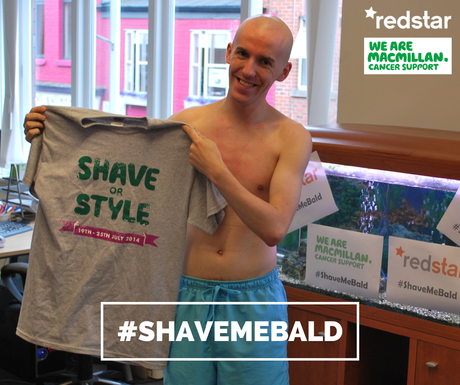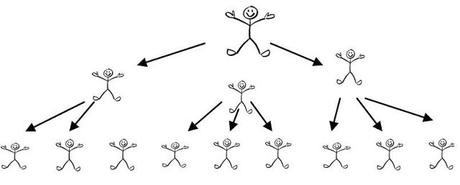

In July I let the team at RedStar, a digital agency in Manchester, shave my body bald. Razors were taken to my head and body, all in the name of Macmillan Cancer Support.
Rather than use the #ShaveOrStyle hashtag Macmillan had asked, I wanted to use another tag #ShaveMeBald so I could see the direct effect my going bald would have across Twitter and other social media platforms.
In this article I want to share how I went about using the hashtag to reach over 1 million twitter timelines, being seen by over half a million times and using only 68 contributing accounts. This article is not about why I wanted to reach out on twitter for Macmillan, rather how I did it, so that you too can reach out for a charity online.
This is a guide for charities and organisations, not for individuals.

Amplify Charity Stories with Social Media
Social Media may seem like just a “fad” or something people use to share useless tittle tattle, and of course food porn – but the reality couldn’t be more different.
Social Media is about engagement with an audience. Social Media is about connecting with those around you and around the world – it’s not just food and cute cats. Social Media, today, has the power to make the average joe user into a superhero. It’s true, Social Media really can give you and me the power to create an impact like never before in our history, one voice really can change the world.
A while ago I wrote about how stories can power brands online, and it is the same story with telling a story on social media for charity. By telling a simple and evoking story effectively, through media such as photos video and blogs, you really can create a powerful message that is likely to be spread wide and far – highlighting the cause. But telling a story doesn’t mean it will instantly get shared, to ensure that you will need to effectively implement the following 3 steps.
- Attract users who are active online.
- Prompt them to take meaningful actions & become supporters.
- Empower them to become real advocates & YOUR superheros.
Attracting Active Users
Social Media is about engagement, and not just spamming your followers. What you want as a great charity online is to have people talking about the issues relating to your charity, both on social media and across the web – and not just when you are talking. To ensure this you need to attract the right kind of user to follow you and engage with you, you can do this by following influencers who can affect your charity, by engaging with them directly, but you can also look to “average joe” by using Hashtags (#’s) to make it easier to find your conversations on certain topics.
Remember as a charity building its online profile using social media you are looking to tap into existing communities and conversations, but most of all you are looking to cultivate interest in your cause, not simply ram it down the throats of anyone who wants to read your feed.
Taking Meaningful Engagement to Online Support
Social Media is fantastic for creating initial interaction and conversation, but it’s not really a transactional tool – at least not in the sense of a website sign up or conversion. So how do you scale this gap between social media and website to create a “meaningful engagement”?
First, let me define “meaningful engagement”, by this I am talking about a real-life engagement with your charity, such as donating or signing a petition.
To bridge the void there are many action you can take, below are just a few ideas which are proven effective:
- Implement Social Sign-in / Logon to your website
This means allowing users to login with Facebook, Twitter or Google – this means its not only easy to sign in for registered users but also easier to get sign up’s to your website and therefore newsletters. This eventually can turn into donation, but if nothing else keeps your charity in their brains! - Use Apps on Social Media to Create a Sign Up
Through apps like MailChimp for Facebook or Infusionsoft you can begin to ensure that your social media engagement transfers into newsletter sign up’s and leads you can follow-up. - Allow Blog Comments via Social Media Accounts
Through plugins to websites, such as disqus, you can increase website engagement by allowing users to use social media accounts to leave comments – many of these are usually shared with that social media account. This is a great way to increase engagement on your site and with your cause on social media. - Think Big, Think Retail, Think Smart
The majority of giving to charities remains from offline sources, direct debits and one-off giving, but donations online usually come with less overheads and this means more money can go towards the cause a charity is representing. In order to move from mainly offline to mainly online sources of income Charities need to think like Retailers and learn from them. Look at how “buy now” buttons are implemented and the psychology behind them, from this you could learn where and when its effective to put a donation button. You can also look at the psychology of forms from retailers and how lots of fields in a form could prevent a sign up or donation – Think Big, Think Retail, Think Smart. Your website is part of your social media strategy.
Moving from Online Supporter to Advocate / Superhero
The move from supporter to advocate is fairly easy. As a supporter you already have a user who wants to help your cause and make a difference, turning them into an advocate. For this case an Advocate is simply a supporter who has taken an extra step and actively promotes your cause, be this through promoting events and petitions to taking part in or organising an event for your Charity. As a charity you will know how to do this and create Advocates for your charity – once they are advocates it is up to YOU to turn them into a superhero!
Importantly, you do NOT want every advocate to become a superhero. Instead you want to leverage specific advocates who have influence with a specific audience (in most cases), but these shouldn’t simply be those you think will gain you traditional media coverage instead they should be those who can influence a community or set of communities through social media. I, myself, would be a good example of this, I can not only tap into parts of the Manchester Tech and Web communities but also those who follow my blog (SEO Andy) and residents of local communities. Another good example could be a celeb who has ties with your cause and a local community, for example Julie Hesmondhalgh, Hayley from Coronation Street, who is closely tied with Willowwood Hospice and Reubens Retreat.

But don’t just think about direct connections to communities, think about relationships they have with others on social media, for example my involvement in local politics means I’ve got connections with those charities may see as key influencers such as MP’s – it’s not all about communities I am connected to but also if someone becomes an advocate for the events I take part in also their network of communities. From this you can get from one or two communities reached (which is what you will see usually when someone fundraises from family and friends) to reaching potentially 50 or 100 communities easily as the advocacy and trust is paid forward from one advocate to another. It’s through this system and making use of planning within it that you can have just 68 people create an impact to over 1 million timelines and have a hashtag (#shavemebald) seen over 500,000 times.
It’s called “paying it forward” and your superhero needs to be at the top.
So, how do you turn an advocate into a Superhero?
The answer is simple, you talk to and engage with your advocates – you don’t sell them on “giving more” to you, they already want to give you time and effort and probably skills. Discuss with them ideas for how they can get involved in your charity, even if it’s attending a free seminar or writing about why they support you online.
The point here is that clear friendly communication with your advocate will, in a short space of time, turn them into a Superhero who simply won’t shut up about your work and an event they are doing. The first step is to talk to them on social media in a friendly way, and get retweet some of the work they do for you – show them you truly appreciate them.
Why I Wanted To Be A Superhero for Macmillan Cancer Support
I did say at the top of this article, this wasnt about why I wanted to use the hashtag but how I did so. Now that you know how, I want explain why…
Macmillan Cancer Support are about holistic care for cancer sufferers and their familes, friends etc. Macmillan staff are among the nicest in the world, from nurses to counsellors to fundraising volunteers.
I wanted to give something back to Macmillan, not in monetary terms (though we did raise over £800 between offline giving, justgiving and the official donation page) but rather raising awareness of their “shave or style” event — such as to encourage others to take part, even if it was just by talking about the event, cancer and becoming aware of the work Macmillan do each and everday.
We all know someone who has been affected by cancer, Macmillan truly help everyone affected by Cancer. Please support Macmillan.
—
A massive thanks must go to:
RedStar — Where I work & for shaving me bald.
Tameside Labour Party — for thier massive support.
Jonathan Reynolds MP & Andrew Gwynne MP.
Sarah Petrie — My other half & Piano Teacher.
and of course, Macmillan Cancer Support
How you can reach over 1 million timelines, without huge effort. was originally published in SEO Andy on Medium, where people are continuing the conversation by highlighting and responding to this story.

